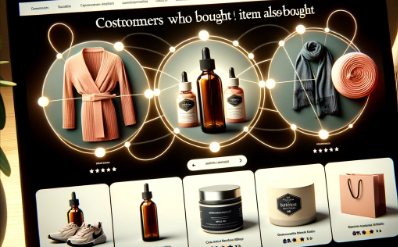Upselling and cross-selling are powerful strategies. They not only boost revenue but also enhance customer satisfaction by offering more valuable options.
Mastering these arts is essential to deepening customer relationships by adding value to their purchases that better meet their needs. And, this is especially beneficial in today’s competitive business landscape.
These two powerhouse sales techniques have transformed the way businesses increase their revenue. I will guide you through what these terms mean and why they’re so crucial for business growth.

What are Upselling and Cross-Selling?
Upselling involves encouraging customers to purchase a more premium or advanced version of what they are already interested in. This might mean suggesting a higher-end model of a product or an upgraded service package.
On the other hand, Cross-Selling is the art of suggesting complementary products or services alongside the original item being purchased. It’s about creating a package of products that together fulfill more of the customer’s needs and desires.
The Importance of These Sales Strategies in Business Growth
Upselling and cross-selling are more than simple sales tactics. More importantly, they are growth strategies. Businesses can increase average transaction sizes and customer lifetime value, which are crucial metrics in any growth strategy, by effectively implementing these techniques.
Therefore, implementing upselling and cross-selling can significantly impact the bottom line. These strategies not only increase the average order value but also improve customer retention by providing a more tailored shopping experience.
Hence, they are key in transforming single-time buyers into loyal customers. In other words, both approaches aim to maximize the value of customer interactions.
Realizing the Value of Knowing Your Customer for Effective Upselling and Cross-Selling
Understanding customer needs, preferences, and purchasing patterns is fundamental to successful upselling and cross-selling. Tailored recommendations based on customer insights are more likely to resonate and lead to additional sales.
Moreover, effective upselling and cross-selling require a deep understanding of the customer. This involves knowing their preferences, purchase history, and even their browsing behavior.
As such, personalized recommendations based on this understanding are more likely to be successful.
Mastering the Art of Upselling | Real-World Examples
Exploring Upselling in Various Industries
Each industry has unique opportunities for upselling. In hospitality, it might be room upgrades; in retail, higher-end products; and in technology, premium software features.
For example, upselling can manifest as offering a room with a better view or additional services like spa packages in the hospital industry.
A customer already booked for a standard room may appreciate the opportunity for a more luxurious experience.
Whereas in retail, it could mean suggesting a higher-quality version of a product, such as a luxury brand of a handbag. On the other hand, clothing stores often upsell by suggesting a matching accessory when a customer picks out a dress or a suit.
It’s about creating a complete look making it convenient for the customer to purchase all the elements in one place. This could potentially come with a ‘complete the outfit’ discount.
Upselling Strategies in the Software Sector
Likewise, look at a well-known software company. They often offer basic versions of their software to gradually introduce the benefits of premium features using:
- Targeted emails.
- App notifications.
- And, product tutorials
This nurturing approach takes time but can result in a customer choosing to upgrade to a more robust, feature-rich software package.
The Role of Customer Satisfaction in Successful Upselling
Most importantly, successful upselling is directly linked to enhanced customer satisfaction.
For example, customer satisfaction with the purchase increases when they feel they are getting better value or a superior product.
Utilizing Data Analytics for Targeted Upselling Offers
In addition, analytics might reveal that customers who buy a particular product often look for specific add-ons. Ultimately, it allows businesses to tailor their upselling strategies accordingly.
Finally, customer feedback is vital in refining cross-selling strategies. It helps in understanding what works and what doesn’t, leading to more successful future campaigns.
Navigating Through Cross-Selling Opportunities
Techniques in the Financial Services Industry
The financial sector introduces cross-selling techniques to enhance customer value and deepen banking relationships.
For instance, offering a savings account to a customer who has just opened a checking account, or suggesting a personal loan to someone with a mortgage. These exemplify strategic cross-selling that addresses customer needs while promoting financial stability and growth.
Bundle Deals and Seasonal Offers in Retail
Similarly, retailers leverage cross-selling through creative bundle deals and special seasonal offers. These tactics not only offer customers better value but also increase sales volumes.
Some examples are bundling products like a camera with a case and memory card, or crafting special holiday bundles. These are effective ways to encourage customers to make additional purchases that complement their primary buy.
Incorporating Cross-Selling Within E-commerce Platforms
In the digital realm, e-commerce platforms have mastered the art of cross-selling by utilizing sophisticated algorithms to suggest complementary products.
Items often displayed under sections like “Frequently bought together” or “Customers who bought this item also bought” significantly enhance the online shopping experience by offering personalized recommendations.
Furthermore, this not only increases the average order value but also improves customer satisfaction by simplifying the search for related products.
How Customer Feedback Shapes Future Strategies
Moreover, the role of customer feedback in shaping cross-selling strategies cannot be overstated. Businesses that listen to their customers can fine-tune their cross-selling approaches, making offers more appealing and relevant.
Also, analyzing customer feedback provides insights into preferences and purchasing behavior. It enables companies to adjust their strategies accordingly and ensure that their cross-selling efforts resonate well with their target audience.
This iterative process fosters a customer-centric approach to sales, ensuring that businesses remain responsive and adaptable to changing customer needs and preferences.

Best Practices for Ethical Upselling and Cross-Selling
Balancing Sales Goals with Customer Experience
Remember, while achieving sales targets is important, it should never come at the cost of customer experience. The focus should always be on providing value to the customer.
In other words, the pursuit of sales targets should never overshadow the importance of customer experience. Upselling and cross-selling should feel like a natural part of the buying process, not a forceful sales pitch.
The Importance of Transparency
Transparency is key in these strategies. Customers should never feel deceived or pressured into making a purchase.
Transparency in these strategies ensures that customers feel informed and in control of their purchasing decisions. Clear communication about the benefits and costs of upgrades or additional products is key.
Training Your Team for Customer-Centric Upselling and Cross-Selling
Teams should be trained to recognize customer needs and offer upsells and cross-sells that genuinely add value to the customer’s purchase.
Sales teams should be trained to understand customer needs and recognize when an upsell or cross-sell is appropriate. This approach ensures that suggestions are relevant and add real value to the customer’s experience.
Building Trust and Long-Term Relationships Through Responsible Selling
Ultimately, the goal of upselling and cross-selling should be to build long-term customer relationships based on trust and mutual benefit, creating a loyal customer base and driving sustainable business growth.
By focusing on the customer’s needs and offering solutions that genuinely enhance their experience, businesses can build trust and foster long-term relationships. This ethical approach to selling not only drives immediate sales but also ensures customer loyalty and long-term business success.
Recap | Upselling And Cross-Selling Strategies
Let’s recap what we have covered:
- Upselling and cross-selling go beyond increasing sales figures. They are about enhancing the customer’s experience and journey with a brand.
- These strategies, when executed with skill and ethical consideration, have the power to transform the customer relationship into a more fulfilling and mutually beneficial one.
- Therefore, upselling and cross-selling should be viewed as opportunities to add value to the customer’s purchase, rather than merely a means to boost revenue.
- This customer-centric approach is vital in building trust and loyalty, which are the cornerstones of long-term business success.
- Moreover, the ability to offer tailored, relevant recommendations is a significant competitive advantage in an era where consumers are bombarded with choices.
- Furthermore, businesses can make informed decisions about which products or services to upsell or cross-sell by leveraging customer data and feedback. This ensures that these offers are timely, appropriate, and likely to be well-received.
- Ethical considerations are paramount in the deployment of upselling and cross-selling strategies. Transparency, honesty, and respect for the customer’s needs and preferences should guide all sales initiatives.
- The focus should always be on creating a positive customer experience, with sales as a natural, unforced result of this experience.
- Additionally, a well-trained team that can identify customer needs, make appropriate suggestions and convey the value of an upsell or cross-sell in a customer-friendly manner is invaluable.
- Ultimately, the journey towards creating lasting customer relationships and a thriving business, mastering the art of upselling and cross-selling is not just beneficial — it is essential.
I hope “Upselling And Cross-Selling Examples | Powerful Strategies” has been beneficial to you? Please feel free to leave your questions and comments below.
Veron | Entrepreneur | The Way 4Word Enterprises | Premium Member, Wealthy Affiliate